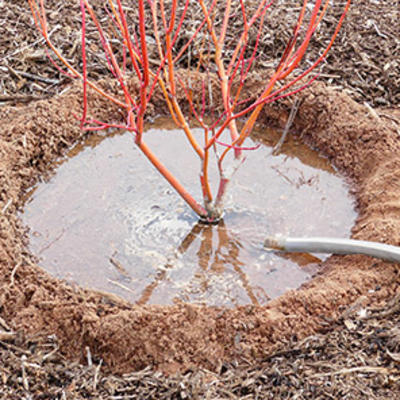
Sara Williams
Saskatchewan Perennial Society
With an average annual precipitation of 30 to 50 cm (12–20 in.), and with about half falling as snow, most plants require some degree of irrigation on the Canadian prairies during the growing season. Our philosophy should be to satisfy the needs of our plants without wasting water.
Understanding the relationship between water, soil and plants helps. Water, whether from rainfall or irrigation, percolates into the soil from the surface, filling the pore spaces between the solid soil particles and forming a “wetting front” that moves downward through the soil.
Different soils absorb and hold water at different rates. The amount of water the soil is able to absorb is called its “water-holding capacity” and is directly related to the organic matter content of the soil and the soil texture. Sandy soils absorb water quickly but have a low water-holding capacity, so lose it quickly as well. The same volume of water moves further and more rapidly in sandy soil. Clay soils absorb water more slowly and are prone to runoff and puddling if water is applied faster than it can be absorbed. The more organic matter, such as compost, that is added to the soil, the greater its water-holding capacity.
Plants themselves require the same amount of water whether grown in a clay or sandy soil. But plants grown in a sandy soil will have to be watered more frequently to obtain the same volume of water. 2.5 cm (1 in.) of water will penetrate to a depth of about 30 cm (12 in.) in a sandy soil and to about 15 cm (6 in.) in a clay soil.
By weight, water makes up 80 to 90 percent of herbaceous annual and perennial plants and about 50 percent of trees and shrubs. Photosynthesis and nutrient transport depend on water. Soil nutrients are brought to the root, enter the root and are carried through the plant in water. It is the internal water pressure that causes cell walls to stretch and cells to grow. As each of the many thousand cells forming a plant enlarges slightly, we see the overall effect as plant growth. As plants increase in size and their root systems penetrate deeper into the soil, irrigation should be less frequent but for longer periods of time, so the water will reach the deeper roots.
How to water
Ideally, water should be applied to the soil, where it can be absorbed by plant roots, rather than to the foliage. When watering established plants, water deeply and thoroughly, to the depth of their root system and beyond to encourage deeper rooting. Roots will only grow where soil is moist. Frequent shallow watering confines roots to the upper level of the soil, leaving plants with a shallow root system prone to drying out between waterings. Greater root growth allows greater water uptake.
Be aware of competition from aggressive plants with extensive, fibrous root systems. The shallow, far-reaching roots of poplar, Manitoba maple, Siberian elm and spruce can rob moisture intended for a nearby lawn, vegetable garden or flower bed.
Remember the trees
Watering your lawn does not mean you have watered the trees in it. Newly planted trees and shrubs need regular watering from planting time to establishment – usually two or three growing seasons. Water (or check the soil to see if water is needed) twice a week during their first month and once a week for the remainder of that season. Through their second and third seasons, water deeply twice a month or as needed. Water mature trees at their “drip line” rather than at their trunk. This is the soil area below the furthest extent of the tree’s branches. Feeder roots – those which absorb water and nutrients – usually end just beyond the drip line and are within the upper 40 cm (16 in.) of soil. Set a soaker hose under the drip line and leave it on until the soil is moist to that depth.
Retired from the University of Saskatchewan, Sara’s most recent book is Growing Fruit in Northern Gardens with Bob Bors. She’s been hosting garden tours for over 20 years – to Great Britain, Ireland, Europe, Turkey and Iceland. Join her for a tour of French gardens this September [Contact Ruth at 1-888-778-2378, www.worldwideecotours.com]
This column is provided courtesy of the Saskatchewan Perennial Society (SPS; saskperennial@hotmail.com ). Check our website (www.saskperennial.ca) or Facebook page (www.facebook.com/saskperennial) for a list of upcoming gardening events

